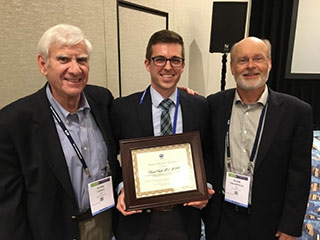March 25, 2019

Croft, middle, accepts the ATS David Bates Award with mentors Utell, left, and Mark Frampton, M.D., right.
(Photo courtesy of George Thurston)
The American Thoracic Society (ATS) Assembly on Environmental, Occupational and Population Health, awarded Daniel Croft, M.D., the David Bates Award for the best submitted abstract in the field of environmental or occupational health at the ATS 2018 International Conference. Croft presented his findings on “The Impact of Air Pollution Regulations on the Incidence of Hospitalizations and Emergency Department Visits for Respiratory Infections in New York State.” Croft is an assistant professor in the Division of Pulmonary and Critical Care Medicine (PCCM) at the University of Rochester Medical Center (URMC) and is also a member of the URMC Environmental Health Sciences Center (EHSC). His research focuses on relationships between air pollution and respiratory infections, and interventions for people with chronic lung disease.
For his award-winning research, Croft and his team explored whether policy initiatives intended to reduce air pollution resulted in changes in hospital admissions and emergency department (ED) visits related to lung infections. New York (NY) state policy changes over the past 10 years have resulted in reductions in air pollutants including particulate matter. During this time, air monitoring sites in Buffalo, Rochester, Albany, Bronx, Manhattan, and Queens had been providing data on ambient particulate air pollution concentrations.
In collaboration with colleagues at the University at Albany - State University of New York, Croft gathered data for NY adults living within 15 miles of the air monitoring stations from the Statewide Planning and Research Cooperative System (SPARCS). Using advanced statistical analyses, he measured the excess rate of hospitalizations and ED visits in relation to increased air pollutant levels in ambient air over three time periods: before policy changes (2005-2007), during policy changes (2008-2013), and after policy changes (2014-2016).
His team observed that concentrations of several air pollutants decreased over the course of the study, including particulate matter less than 2.5 micrometers in size (PM2.5), ozone, sulfur dioxide, and nitrogen dioxide. However, the rate of respiratory infection hospitalizations and ED visits associated with increased pollutant concentrations persisted. Though overall PM2.5 concentrations were lower over time, Croft found that some components of PM2.5 increased. Furthermore, the rate of respiratory infection hospitalizations and ED visits per unit mass of PM2.5 were equivalent or greater after this change in PM composition was noted.
“This is an important area of research for policy makers as we try to understand what components of PM2.5 are the most dangerous to human health and consider policies to reduce levels of these specific components in our environment,” explained Croft.
Croft joined URMC in 2014 and credits the EHSC with accelerating his path to becoming an independent researcher. He is grateful for the guidance provided by his mentors, Mark Utell, M.D., and David Rich, Sc.D., among others at the EHSC.
“The EHSC has provided great networking opportunities with experts from other institutions who have helped inform my research,” Croft said. “The EHSC has also connected me to local resources including the American Lung Association to help develop my clinical education series on electronic cigarettes.” He recently submitted a pilot project application in collaboration with the Community Engagement Core at the EHSC to support education and report-back of results of a community-based project on home air filtration.


